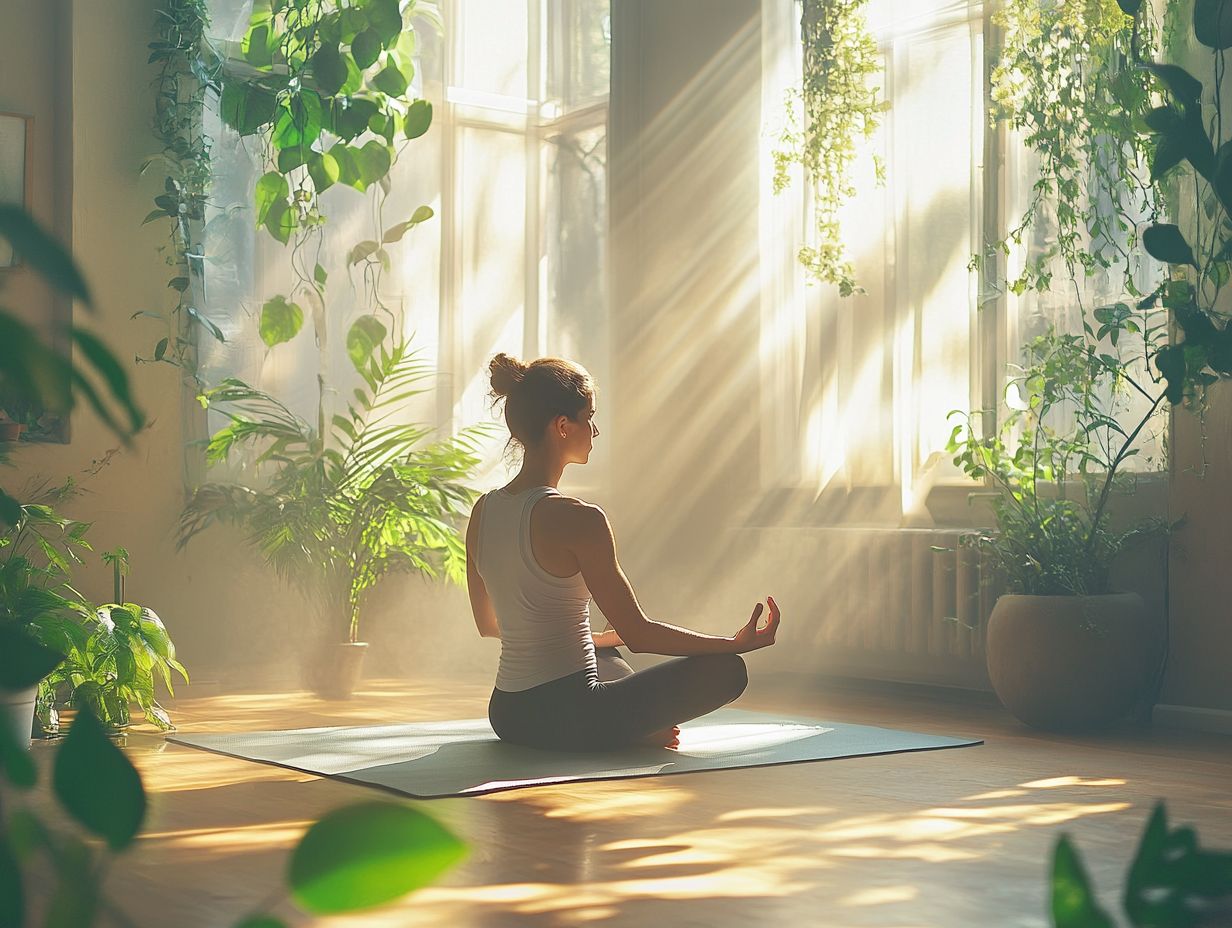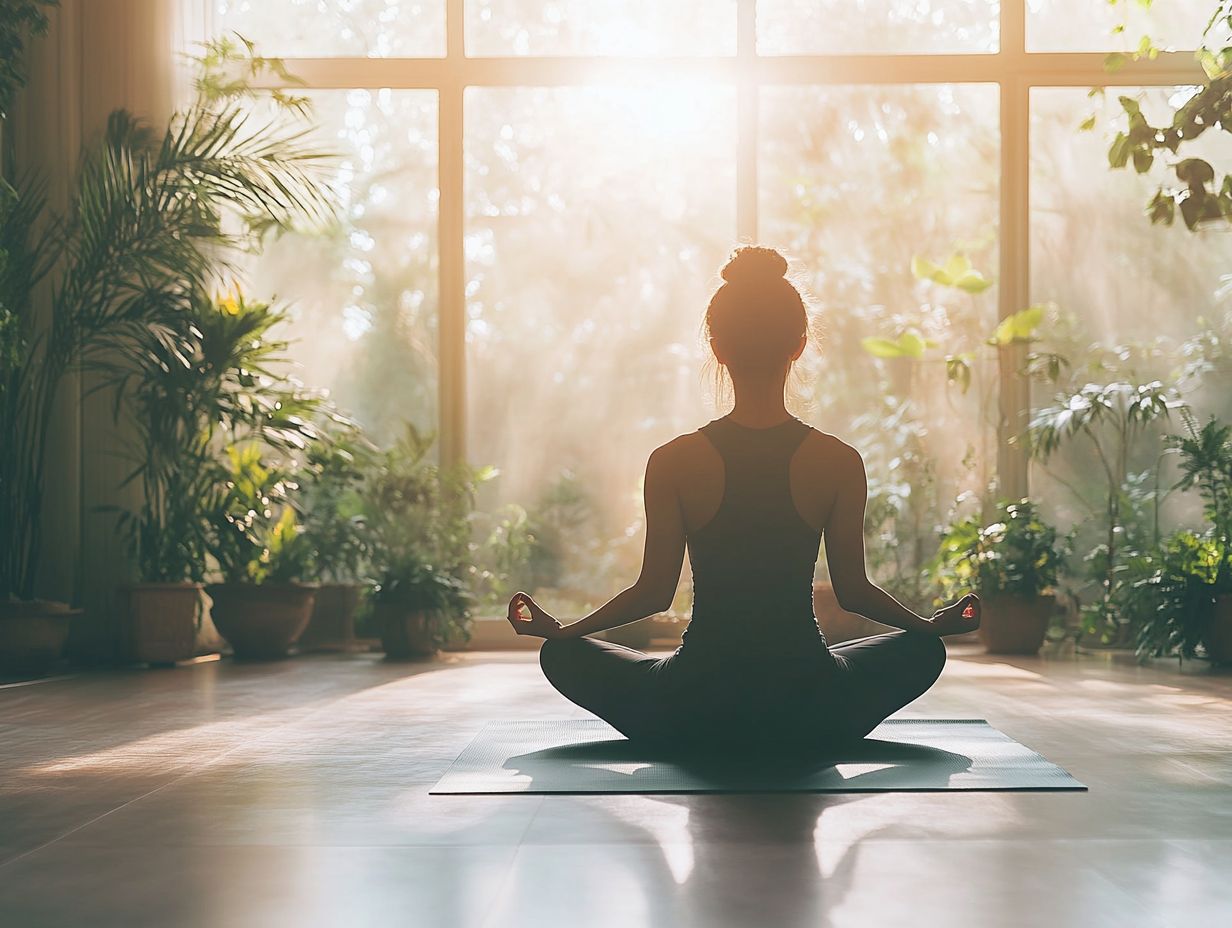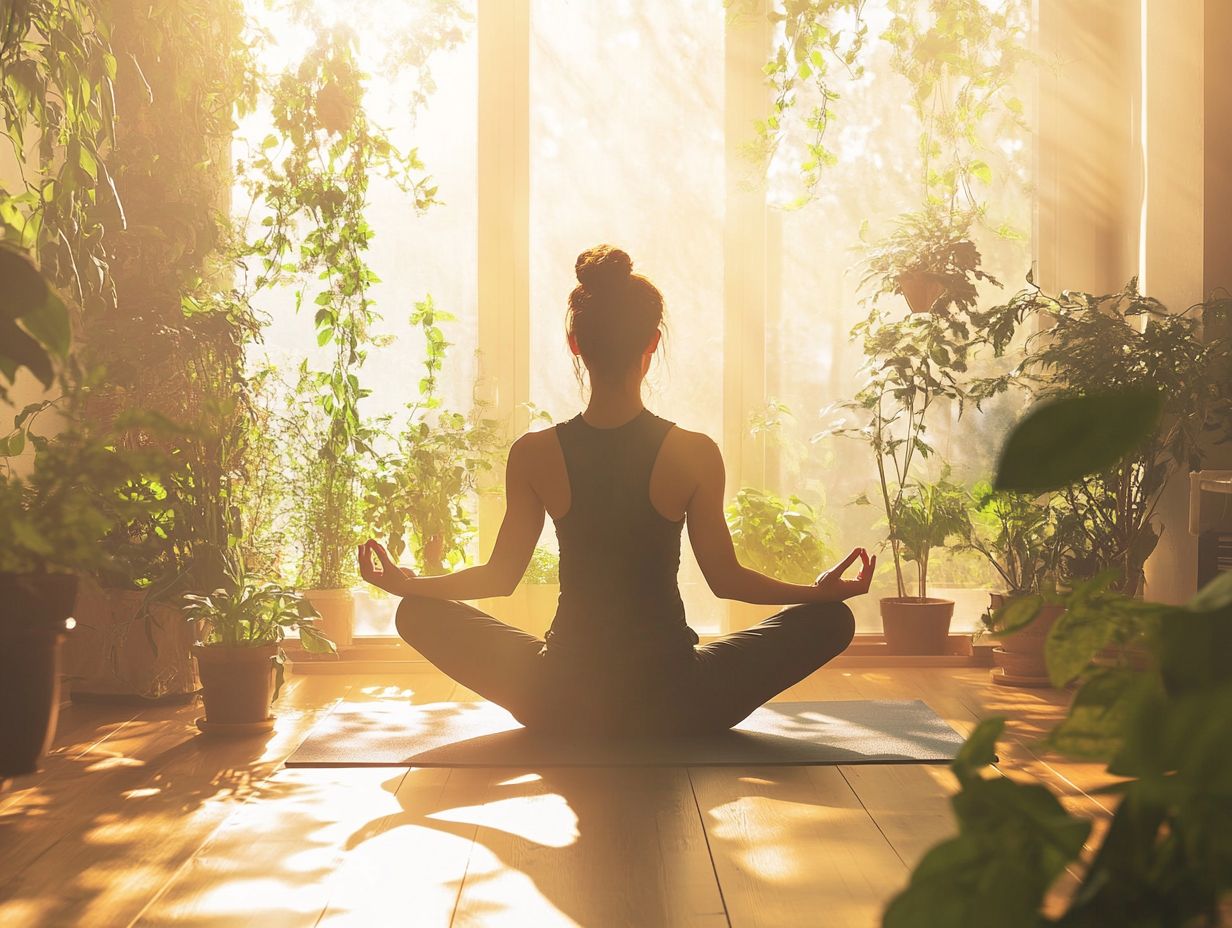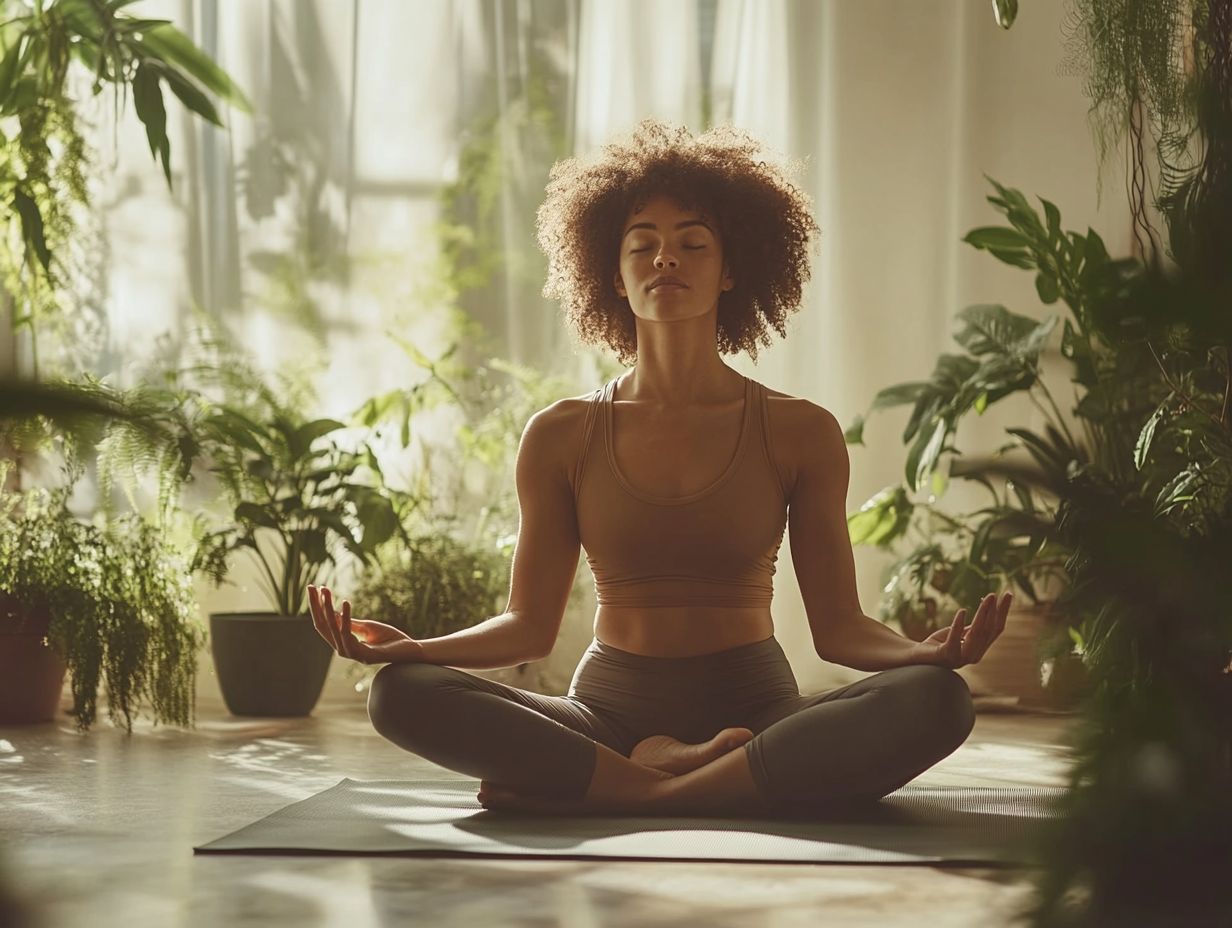5 Effective Breathing Exercises for Anxiety
In today s fast-paced world, anxiety can often feel like an overwhelming presence, influencing not just your thoughts but also your physical state particularly your breathing.
This article delves into five effective breathing exercises specifically designed to combat anxiety and foster relaxation. From diaphragmatic breathing to the 4-7-8 technique, each method presents unique benefits that can help you regain control over your breath and, ultimately, your sense of peace.
You ll also explore how anxiety affects breathing, the myriad benefits these exercises offer, and practical tips for seamlessly integrating them into your daily routine.
Discover how simple adjustments to your breathing can lead to significant transformations in your mental well-being.
Contents
- Key Takeaways:
- 1. Diaphragmatic Breathing
- 2. Equal Breathing
- 3. Alternate Nostril Breathing
- 4. Experience the 4-7-8 Breathing Technique
- 5. Discover Progressive Muscle Relaxation
- Understanding Anxiety: How It Affects Your Breath
- What Are the Benefits of Breathing Exercises for Anxiety?
- How Often Should One Do Breathing Exercises for Anxiety?
- Are There Any Precautions to Take When Practicing Breathing Exercises?
- Can Breathing Exercises Be Used as a Standalone Treatment for Anxiety?
- What Other Techniques Can Be Used in Conjunction with Breathing Exercises for Anxiety?
- Frequently Asked Questions
- What are some effective breathing exercises for anxiety?
- How does deep breathing help with anxiety?
- What is diaphragmatic breathing and how does it reduce anxiety?
- Can breathing exercises be done anywhere?
- How often should I do breathing exercises for anxiety?
- Are there any other benefits of practicing breathing exercises for anxiety?
Key Takeaways:

- Diaphragmatic breathing calms your mind and reduces anxiety.
- Equal breathing balances inhalation and exhalation, helping you relax.
- Alternate nostril breathing improves focus and reduces stress.
1. Diaphragmatic Breathing
Diaphragmatic breathing, also called belly breathing, is an effective technique. It encourages deep inhalations and exhalations, helping you relax and reduce stress. This practice can significantly boost your mental health, especially if you’re navigating anxiety. By using your diaphragm fully, you fill your lungs with air, creating a soothing sense of calm and tranquility ideal for anyone seeking relief from the physical signs of anxiety and stress-related conditions.
To practice diaphragmatic breathing, follow these steps:
- Find a comfortable position, whether sitting or lying down.
- Place one hand on your chest and the other on your abdomen.
- Slowly inhale through your nose, allowing your diaphragm to expand fully.
- As you exhale gently through your mouth, feel the hand on your abdomen lower as the air is expelled.
Research in Frontiers in Psychology highlights the effectiveness of this technique for managing anxiety disorders, demonstrating health benefits like reduced heart rate and blood pressure while also addressing the physical signs of anxiety.
You can integrate diaphragmatic breathing into your routine as a quick and effective way to de-stress, enhancing your overall well-being and improving your ability to cope with the demands of your profession.
2. Equal Breathing
Equal breathing is a simple yet powerful technique that cultivates a harmonious state of calmness. By synchronizing the duration of your inhalations and exhalations, you can promote relaxation and mindfulness.
To practice this, focus on breathing in for a count of four or five seconds, then mirror that duration for your exhalation. This creates a soothing rhythm that alleviates tension and sharpens your awareness. Start by finding a comfortable seated position, closing your eyes, and taking a moment to observe your breath before you begin the counts.
With consistent practice, this technique can become an invaluable tool in managing anxiety and stress, helping you anchor yourself in the present and foster a deeper sense of tranquility.
3. Alternate Nostril Breathing
Alternate nostril breathing, or nadi shodhana, is a highly esteemed technique in yoga that helps balance your body’s energy, calm your mind, and reduce stress making it an excellent choice for alleviating anxiety.
This practice is steeped in the rich traditions of ancient India and is commonly woven into various yoga styles, including Hatha and Kundalini. To get started, find a comfortable seated position with your spine straight. Using your thumb and ring finger, gently close one nostril at a time while you inhale and exhale deeply through the other.
This systematic alternation not only promotes a harmonious flow of prana which means life energy in yoga but also enhances your overall mental clarity. As you engage in this rhythmic breathing technique, you cultivate mindfulness, enabling you to navigate daily challenges with enhanced resilience and tranquility.
Start your journey to a calmer mind today by giving these exercises a try!
4. Experience the 4-7-8 Breathing Technique

The 4-7-8 breathing technique offers a structured approach that promotes relaxation by guiding you through a specific pattern of inhalation, holding, and exhalation. This method eases anxiety and fosters a profound sense of calm.
Rooted in ancient yogic practices, this technique gained prominence through Dr. Andrew Weil, who highlighted its remarkable ability to reduce stress and enhance overall mental well-being. To perform it, inhale deeply through your nose for a count of four, hold your breath for seven counts, and then exhale slowly through your mouth for eight counts.
Experience the magic of rhythmic breathing that not only calms your nervous system but can also be seamlessly integrated into your daily routine. Engaging in this practice for just a few minutes during stressful moments whether at work, at home, or even while commuting can serve as a powerful tool for managing anxiety and building resilience.
5. Discover Progressive Muscle Relaxation
Progressive muscle relaxation is a step-by-step method that invites you to tense and then relax various muscle groups throughout your body. When paired with deep breathing exercises, this technique can profoundly alleviate stress and anxiety.
As you guide yourself through a series of controlled muscle contractions followed by deep relaxation, you’ll find a practical way to release physical tension. Experts like Adele Burdon-Bailey emphasize its effectiveness, noting how it can reduce perceived stress levels and enhance your overall well-being.
To begin, find a comfortable space where you can fully focus on your breath and create a calming atmosphere. Gradually work your way through muscle groups, starting from your toes and moving up to your head. This method ensures a thorough release of tension while deep breathing amplifies the calming effects.
This practice is not only beneficial but also easily accessible for anyone seeking relief from daily stressors.
Understanding Anxiety: How It Affects Your Breath
Anxiety is a multifaceted psychological condition characterized by overwhelming worry and fear. It often shows up physically, particularly through breathing disturbances. You might notice symptoms like shortness of breath and an increased respiratory rate. Grasping how anxiety impacts your breathing is crucial for devising effective coping strategies. Use relaxation techniques and breathing exercises to manage these physical manifestations and ease discomfort in your everyday life.
If anxiety has been a frequent companion, you might find yourself caught in a relentless cycle of panic and hyperventilation. This occurs when your body s stress response activates the sympathetic nervous system the part of your nervous system that controls your fight-or-flight response. Consequently, you experience rapid heart rates and shallow breathing, amplifying the distress of the moment.
Understanding how anxiety modifies your breathing mechanics sheds light on possible interventions to help restore your sense of calm. We encourage techniques like diaphragmatic breathing and mindfulness meditation, which not only encourage relaxation but also enable you to regain control over your breath. This fosters improved mental clarity and emotional balance, guiding you toward a more tranquil state of being.
What Are the Benefits of Breathing Exercises for Anxiety?
Breathing exercises present a wealth of benefits for those navigating the challenges of anxiety. In addition to these practices, consider implementing positive lifestyle changes to reduce anxiety for improved emotional regulation, decreased physiological stress responses, and an enhanced sense of calm, all contributing to better mental health.
Research from reputable sources like Psychology Today underscores that structured breathing techniques can effectively lower cortisol levels, the hormone linked to stress, leading to a significant reduction in anxiety symptoms. For instance, a study conducted at Brigham Young University revealed that individuals practicing deep, diaphragmatic breathing saw a remarkable shift in mood and a decrease in heart rate, enabling greater focus and emotional stability.
By integrating these methods into your daily routine, you not only build resilience but also enable yourself to manage anxiety more effectively. Don’t wait! Start practicing these techniques now for a calmer life and improved overall well-being through enhanced mental health.
How Often Should One Do Breathing Exercises for Anxiety?

Adding breathing techniques: natural anxiety relief exercises to your daily routine can be incredibly beneficial for managing anxiety. It’s recommended that you practice several times a day to fully harness their calming effects and reinforce mindfulness.
Consider integrating these exercises into specific daily activities, such as before crucial meetings, during lunch breaks, or even while waiting in line. These moments present an excellent opportunity to pause and reset. This allows for a smoother transition back into more demanding tasks.
Morning sessions help you start the day positively. Evening practices might assist you in unwinding and reflecting.
Over time, this structured approach enables you to instinctively use breathing techniques whenever you feel overwhelmed. This further enhances your emotional resilience.
Are There Any Precautions to Take When Practicing Breathing Exercises?
While breathing exercises are generally safe and offer significant benefits for anxiety relief, it’s crucial to take certain precautions, especially if you experience shortness of breath or other respiratory issues. Ensuring a safe practice is essential.
If you have chronic conditions like asthma or COPD, certain techniques might worsen your symptoms. Therefore, approach any new breathing routines with care, as some patterns may lead to discomfort.
Engaging with a healthcare professional before starting any new wellness activities is important. They can provide you with personalized guidance and strategies tailored to your specific health needs. This allows you to enjoy the benefits of these exercises without exposing yourself to unnecessary risks.
Can Breathing Exercises Be Used as a Standalone Treatment for Anxiety?
Breathing exercises can be a valuable tool in managing anxiety. However, relying solely on them as a treatment for anxiety disorders might not be enough for everyone. This highlights the importance of a comprehensive approach to mental health.
Incorporating these breathing practices into a broader treatment plan, which may include therapy and medication, allows you to address the complexities of your anxiety more effectively. Therapy equips you with essential coping strategies while medication helps stabilize your mood. Breathing exercises provide immediate relief and promote relaxation in the moment.
This integrated approach not only reduces symptoms but also helps you cultivate mindfulness and emotional resilience. Combining these strategies creates a multifaceted and holistic treatment that enhances your overall well-being, paving the way for a more balanced life.
What Other Techniques Can Be Used in Conjunction with Breathing Exercises for Anxiety?
Combining breathing exercises with techniques like mindfulness meditation, yoga, and progressive muscle relaxation can significantly boost your ability to manage anxiety. Additionally, making simple changes to reduce anxiety naturally can enhance your overall well-being.
Research shows that integrating these strategies allows you to adopt a holistic approach to anxiety management. For example, the deep breathing practiced in yoga calms your nervous system and fosters a heightened awareness of bodily sensations an essential element during mindfulness exercises.
Participants in various studies report that those who embrace this multi-faceted approach experience quicker reductions in anxiety levels that sustain over time. By harnessing the synergistic effects of these techniques, you can build resilience, transforming your daily experiences and equipping yourself with effective coping mechanisms.
Frequently Asked Questions

What are some effective breathing exercises for anxiety?
Some effective breathing exercises for anxiety include deep breathing, diaphragmatic breathing (which means breathing deeply using your diaphragm), alternate nostril breathing, box breathing, and 5 mindful practices to reduce anxiety through counting breaths.
How does deep breathing help with anxiety?
Deep breathing calms the mind and body. It lowers your heart rate and eases feelings of anxiety.
What is diaphragmatic breathing and how does it reduce anxiety?
Diaphragmatic breathing, or belly breathing, means taking slow, deep breaths. This technique helps to calm your nervous system and reduces anxiety.
Can breathing exercises be done anywhere?
Yes, you can do breathing exercises anywhere! Whether you’re at home, in the office, or on the go, find a moment to breathe deeply.
How often should I do breathing exercises for anxiety?
Practice breathing exercises at least once a day. Feel free to do them more often if you need to calm your nerves.
Are there any other benefits of practicing breathing exercises for anxiety?
Yes! Breathing exercises also improve how you breathe overall, boost lung capacity, and promote relaxation.






